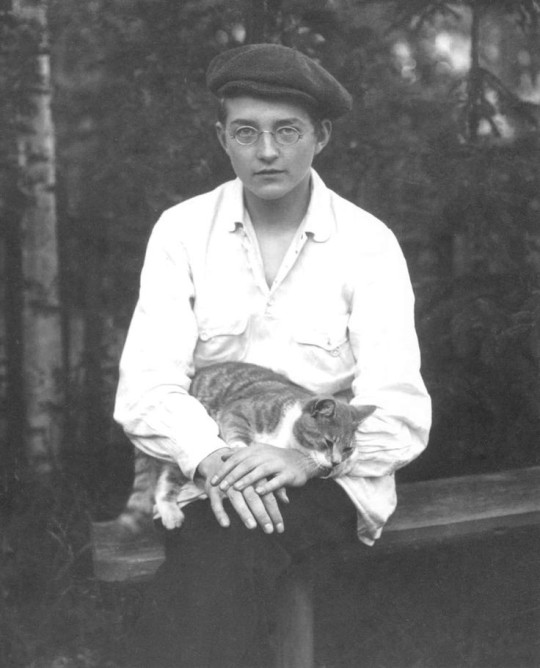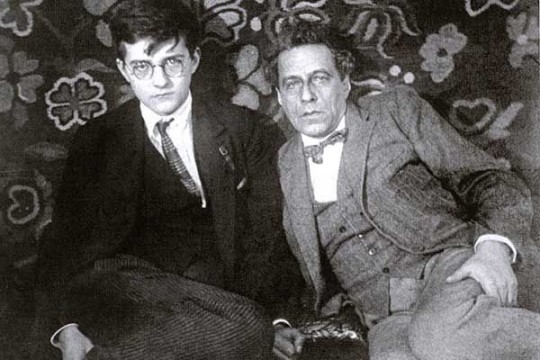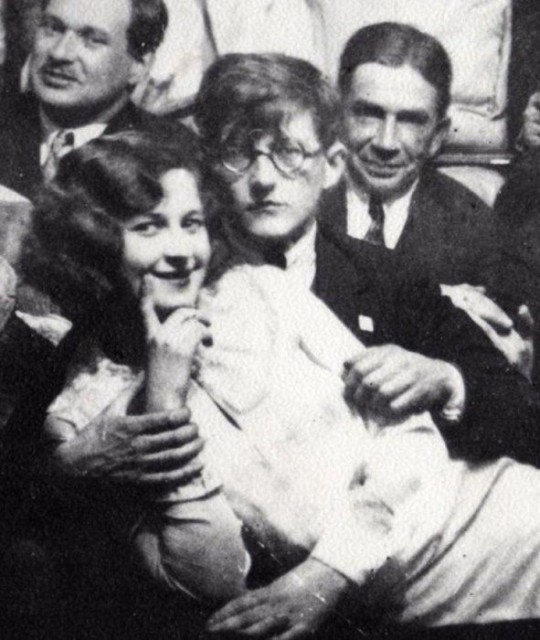#soviet music history
Text
welcome to shostakovich research! here's some stuff to know
1- Trust no one. Not even Shostakovich. Sometimes what Shostakovich says about Shostakovich isn't the exact truth about Shostakovich.
2- You may be reading a harrowing document detailing the restrictions faced by artists in the mid-30s USSR, and then the next letter you read will include jokes about goat shit. This is normal.
3- The more you learn, the more you will discover you don't know. Now is the perfect time to celebrate being an insufferable know-it-all, because that feeling will evaporate as soon as you learn how to spell "Zhdanovshchina."
4- You will soon develop a desire to wear round spectacles and speak in Russian idioms and literary references. Resist it.
5- You will read about a whole cast of Soviet musicians and intellectuals, as well as scholars, political figures, and academics. None of them agree with each other on anything. Have fun.
#classical music#music history#shostakovich#dmitri shostakovich#composer#music#soviet history#soviet music history#classical composer
191 notes
·
View notes
Text

Above is a portrait of Dmitri Shostakovich painted by a friend of his and famous artist, Nikolai Sokolov.
Sokolov was among the many people Shostakovich knew aboard the infamous “Railcar No. 7”, which evacuated some of the Soviet Union’s greatest composers, musicians, artists, and dancers out of Moscow in October of 1941. For six days, an uncomfortable amount of people were packed into the railway car, which moved painfully slowly eastward across the Russian countryside away from the advancing Wehrmacht. During the night, the men would stand and let the women and children sleep. During the day, they would switch, and let the men sleep. This was life aboard their carriage.
At one point, after they’d left the station in Moscow, Shostakovich realized that two of his family’s bags were missing, including all of his clothing and his children’s clothing. Not only that, but a certain third bundle was also missing: the unfinished manuscript for his seventh symphony. While those around him, including his friend Sokolov, managed to spare some clothing for him and his children, they couldn’t quite as easily replace the manuscript. Forlorn, Shostakovich had no choice but to wait on the carriage until they reached their intended destination of Kuibyshev (now known as Samara).
It’s almost a miracle that the Shostakovich family didn’t depart the train sooner like many of those on board had, because on the fourth day, while taking a trip to the toilet, Shostakovich and his wife Nina discovered a familiar looking blanket in a puddle on the floor. Upon unwrapping it, they discovered the manuscript for Shostakovich’s seventh symphony, almost completely untouched despite the conditions in which it was found (they didn’t keep the blanket). Their suitcases, on the other hand, were never found, and were believed to have been left behind on the platform in Moscow during the chaos of evacuation.
That bundle of music would become the most famous piece of music to be composed during the Second World War, and would launch Dmitri Shostakovich into global fame. How incredibly lucky for Shostakovich that the bundle wasn’t thrown out before he had a chance to recover it, or else the world may have never heard his Symphony No. 7.
#dmitri shostakovich#shostakovich#classical music#history#music#soviet union#ussr#russia#second world war#moscow#trains
119 notes
·
View notes
Photo

“I love you, life” - Soviet poster designed by Timofei Lyaschuk (1961)
For reference, “I Love You, Life” is a very popular song from 1956.
500 notes
·
View notes
Text




Happy shostakovich swag winter 🙏🙏
#classical music#opera#ballet#dmitri shostakovich#Shostakovich#russian history#soviet history#vintage photography#vintage fashion#vintage photo#vintage style#1930s#30s fashion
66 notes
·
View notes
Text

A group sings together while camping in the Soviet Union.
USSR
1970
#vintage camping#campfire light#soviet union#ussr#history#camping#hiking#travel#road trips#music#guitars
133 notes
·
View notes
Text
A mural on the Pripyat Music School entitled “Music”.


The mural is made from a traditional Italian mosaic style called Smalti. Small, hand cut glass pieces make up the colors of the mural.
Photo Credits: Andre Josse
#chernobyl#pripyat#disaster#history#accidents and disasters#nuclear power#radiation#nuclear#abandonded#mural#ussr#soviet propaganda#soviet aesthetic#brutalist#music#music school#exclusion zone#aesthetic#autism#soviet art#glass tile#aes#tile mural#pretty#cool as fuck if you ask me#mosaic#mosaic art#glass mosaics#smalti
278 notes
·
View notes
Text
i love my friends so much they always show me incredible new things
#they range from literature i deemed boring in school through soviet movies to 70s japanese rock bands and video games i thought weren't#really interesting. my highschool friend is an opera singer and she would tell me about music history#i don't remember much of it but it was lovely to hear her talk about it#i hope i could one day show them something i find interesting as well but alas. it's either something we already have in common or somethin#they don't particularly care about#which is 100% valid and okay but lowkey hurts sometimes when i know i've already asked them to check out this or that for me and they still#haven't done that for whatever reason#whispers
2 notes
·
View notes
Text
On April 28, 1950, Cossacks of the Kuban debuted in East Germany.

#cossacks of the kuban#cossacks of the kuban 1950#marina ladynina#soviet film#soviet propaganda#musical comedy#1950s film#mosfilm#rom com#romantic comedy#soviet cinema#aoviet culture#movie art#art#drawing#movie history#pop art#modern art#pop surrealism#cult movies#portrait#cult film
2 notes
·
View notes
Text



OTD in Music History: Russian-Soviet composer Nikolai Myaskovsky (1881 - 1950) is born near Modlin Fortress (present-day Poland) in what was then the Russian Empire.
Sometimes referred to as the "Father of the Soviet Symphony,” Myaskosvky was highly acclaimed in his own day. While he was awarded the Soviet Union’s highest honor – the “Stalin Prize” – five times, however, Myaskovsky always remained a rather distant and enigmatic figure. Fundamentally a conservative artist, Myaskovsky nevertheless enjoyed flirting with “modernism” from time to time; possessed of a markedly individualistic spirit, he flourished even within the decidedly collectivist atmosphere of the Stalin-Era Soviet Union.
After enrolling at the St. Petersburg Conservatory in 1906 (at the age of 25), Myaskovsky studied with Nicolai Rimsky-Korsakov (1844 - 1908) and Anatol Lyadov (1855 – 1914) and befriended the young Sergei Prokofiev (1891 - 1953), who was ten years his junior. In his third year at the Conservatory, Myaskovsky composed his Symphony No. 1 – which won him a scholarship that paid for the remainder of his schooling. After graduating in 1911, he initially supported himself by teaching private lessons before eventually securing a position at the Moscow Conservatory.
Myaskovsky rose to international prominence as a composer in the mid-1920s, and throughout the 1930s-40s he continued to churn out a long series of symphonies, piano sonatas, and string quartets. He also notably taught both Aram Khachaturian (1903 - 1978) and Dmitri Kabalevsky (1904 - 1987).
PICTURED: A small photo showing the middle-aged Myaskovsky, which he signed and dated in Moscow in 1936.
#Nikolai Myaskovsky#Myaskovsky#Mikołaj Miąskowski#classical music#music history#classical composer#composer#Father of the Soviet Symphony#classical musician#musician#music#symphony#orchestra#symphonic poem#Overture#Violin Concerto#Concerto#Concert#Dramatic Overture#Cello Concerto#Choral music#Cantata#Nocturne#Sonata#Chamber music#Piano music#Songs
3 notes
·
View notes
Text
youtube
Ukraine, 1877
#ukraine art#ukraine flag#ukraine#ukrart#ukrayna#ukrajina#ukranian#ukranian artist#urss#soviet union#soviet art#soviet aesthetic#post soviet#soviet cinema#russian history#russian art#russian literature#russian#russia#russian wave#russian aesthetic#russian empire#russian revolution#russian folklore#russian fairy tales#russian music#russian vibes#russian culture#soviet history#soviet music
0 notes
Text
Shostakovich-Sollertinsky letter translations (Russian to English)
So, I finally finished formatting my translations of the Shostakovich-Sollertinsky letters from a few years ago! These are letters from Shostakovich to his close friend, the polymath and scholar Ivan Ivanovich Sollertinsky, from the late 1920s to 1943. They offer valuable insight on Shostakovich's opinions on subjects such as music, his personal life, and current events of the day.
The letters have been published in Russian and have also been translated and published in German; an official English translation does not exist as of posting this. I'm not a fluent Russian speaker and much of this was done with the help of a dictionary and the internet, but I believe I compiled a decent enough translation. I kinda had to rush the formatting towards the end, but it should be readable enough. Anyway, if anyone is interested, here it is!
For any Russian speakers who want to review my translations or would like to read the original letters, here is the PDF of the book.
#shostakovich#dmitri shostakovich#classical music#composers#classical composers#music history#classical music history#soviet history#soviet music history#translation#russian to english translation#russian history
26 notes
·
View notes
Text

A favourite of mine, this photo shows a rather foreboding Dmitri Shostakovich vacationing on the coast of the Crimean Peninsula, circa. 1937.
#dmitri shostakovich#shostakovich#classical music#history#music#soviet union#ussr#russia#crimea#ukraine
51 notes
·
View notes
Photo

“Good Bye”, music by Bor Lifshits. Sheet music cover (Kyiv, 1928).
132 notes
·
View notes
Text
you ever just want to cry because you have a shit ton of papers due and absolutely no findings to write about.
it's going great
#i have to write about hip-hop but i have little in terms of actually understanding hip-hop and rap history#and Do Not have time to read everything out there#my conclusions feel so shaky#my other paper is incoherent because i Cannot fucking find sources that deal only with post-soviet music.#everyone wants to write about late soviet works. no. i want shit after 1991. why the fuck is this so hard to find.#and i have. 2 weeks. to get all this figured out#2 proposals written. and one full paper based of of one of those proposals. and a presentation based off of the other one.#plus an auto-ethnography about critical theory that i haven't even started bc i don't have the bandwidth#plus a music theory assignment that i Also haven't started bc i just turned in the last one 48 hours ago. i just.#what the fuck am i doing. i don't fucking know.#everything is Garbage and i don't have time to fix it and i'm Stressin' bc i want to do well! and i'm Absolutely gonna fuck it up bc i have#Nothing To Show For My Work. Fuck.
1 note
·
View note
Text
My YouTube video!!
youtube
1 note
·
View note
Text



Our logo, compared with duplicates of actual prisoner/labourer tattoos for the Norilsk Corrective Labour Camp – or simply, Norillag. This Gulag was established in 1935 in the Soviet Union to handle the construction and subsequent operation of nickel mines and refineries for the Norilsk region. It was closed in 1957.
#norillag#industrial#industrial music#scrap metal#scrap metal percussion#gulag#soviet union#USSR#history
1 note
·
View note